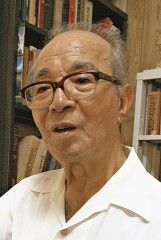Japan Nuclear Fuel considered Yaeyama as a repository for radioactive waste

Seizo Oshiro recalls former permanent secretary for Okinawa Development Agency Sachio Inoue coming to Okinawa to look on an island of Yaeyama for a location for the final disposal of radioactive waste. Oshiro was interviewed by a reporter of Ryukyu Shimpo at his home on September 6.
September 25, 2011 Tsuyoshi Arakaki of Ryukyu Shimpo
In 1980, Sachio Inoue, then a senior advisor of “Nuclear Fuel Services” (now Nuclear Fuel, Rokkasho-mura, Aomori Prefecture), visited Okinawa to look into the building of a facility “on the island of Yaeyama” for the final disposal of radioactive waste. He met with a chief councilor of the Okinawa Prefectural Government (OPG) and talked about “a base for plutonium waste.” The chief councilor speculated that the company was seeking a place to dispose of high-level radioactive waste that needs to be buried deep underground. Nuclear Fuel Services was a state-run company established to operate in the commercial nuclear fuel cycle. Inoue had previously worked as an administrative vice‐minister for Okinawa Development Agency.
In the winter of 1980, Inoue visited Naha City to meet with the chief councilor of the OPG, Seizo Oshiro (now 81 year-old), who had been the director of the Tokyo Office of the OPG for five years from 1973. Inoue invited Oshiro to dinner, and in the course of their conversation, said, “I went to the island of Yaeyama to see if there might be a place there for the final disposal of plutonium, but things weren’t very favorable.” Inoue did not give the specific name of an island. Oshiro said, “Mr. Inoue did not seem very enthusiastic about the task he had been given.” Recalling that day, Oshiro said, “I thought that people in the main islands of Japan were intent on bringing more bad things into Okinawa, on top of the U.S. military bases that no area of Japan was keen to host.” Inoue had served as a budget officer in the Ministry of Finance where, according to Oshiro, “He made significant contributions” in terms of acquiring budget for Okinawa. Inoue was the Director of the Development and Promotion Bureau of Okinawa Development Agency in 1974 and served as the permanent secretary for that agency for two years from 1977.
According to Japan Nuclear Fuel, Inoue became a senior advisor for them in July 1980, working in that role until he passed away in March the following year.
The company did not confirm that they proposed Okinawa as a location for disposal of nuclear waste, going no further than saying, “We have no information on that.”
High-level radioactive waste is now stored as vitrified waste in the long-term storage facility in Rokkasho Nuclear Fuel, with other radioactive waste being placed in the storage pool of nuclear power plant sites, but the location for final disposal is still undecided.
Countermeasures, including technical means for the final disposition of radioactive waste have still not been established because radiation may possibly leak into groundwater even if the waste is sealed with multiple barriers and buried at a deep geological layer. Some experts consider these measures to be insufficient for coping with earthquakes and volcanic activity, and such high-level radioactive waste also attracts attention on an international level because of the possibility of extracting large amounts of plutonium, which can be diverted for use in nuclear weapons.
Hitoshi Yoshioka, vice president of Kyushu University and an expert on science policy, said that seeking a place to use as a radioactive waste repository in Yaeyama “matches the time from the late 1970s when they began looking for land to use as a final disposal site,” and continued by saying, “It cannot be denied that an island in Okinawa may emerge as a possible candidate as a site for final disposal.”
(English Translation by T&CT, Mark Ealey)
Previous Article:Book on the crimes of U.S. Occupation Forces against Okinawan people is published by a former OPG official
Next Article:Monorail featuring a picture of Shuri Castle runs
[Similar Articles]
- U.S. military brings radioactive waste into MCAS Futenma
- Nakagusuku and Kitanagusuku residents’ group asks local sanitation association to refuse U.S. military waste collection
- Number of refugees from Fukushima to Okinawa on the rise
- US military generates largest amount of garbage yet: 2.6 tons, a 11% increase and 1.8 times that generated by Okinawans
- Diesel fuel leaks out of underground tank in Kadena Ammunition Depot
 Webcam(Kokusai Street)
Webcam(Kokusai Street)


